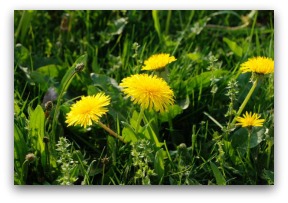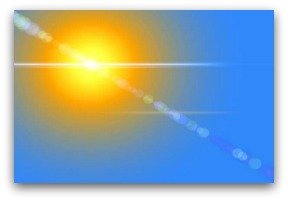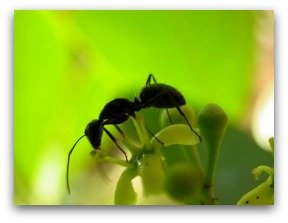A. Grass Problems
Identifying your grass problems, is the first step in determining what action is needed to repair your lawn.
However, not all lawn problems are easy to diagnose, and your problem could also be soil, or maintenance related.
These three things are usually intertwined, so soil problems will follow in the next section.
Minor repairs and preventive maintenance will follow soil problems.
Replacing, and renovating lawns will be covered in later sections.
Why is it important to identify and understand your grass problems before you begin trying to fix them?
You could be wasting valuable time and money if you don't know the “why”, and “how”, of these problems. Seed, sod, fertilizers, herbicides, pesticides, and other products are costly. This makes it important to correct your problem the right way.
You also have a responsibility to the environment. Using certain chemicals, fertilizers, or other products can be wasted or washed into drains.(Just like the money used to buy them). When not used correctly, you can cause damage to the ecosystem with little, or no positive effects on your lawn.
“Dump this on your lawn, and it will kill everything”, is commonly heard, but may not be the best advice. We encourage you to look at the most environmentally conscious option before you do this. This is not meant to discourage you from using these products, we just want you to be responsible when you do.
Ways to get help identifying your problem
The easiest way to identify your lawn problem, is by taking a sample of your lawn to a county extension office. (If you have one.) They have the expertise to analyze the grass and the soil. Agricultural schools can also be a great resource.
Another option is to have a few lawn care companies visit your property. They can diagnose your problem and usually provide you with a quote. Most lawn care companies have dealt with the problems you are having.
You might find it may be more work than you thought, and leaving the work up to them might be an option for you.
You can also call on an experienced landscape company in renovating lawns. They may give you a different perspective than a maintenance company. Just like any good decision in life, gathering information is always the best place to start.
Remember that almost all grass problems are preventable when you follow proper lawn care, and maintenance techniques. Having this information is the key. So let's look at a few common problems and see if we find yours.
Common Lawn Problems
Neglect - Probably the biggest problem, and the reason why most of you are here at this page. It may not have been you. Maybe you purchased a property that had been poorly maintained, or vacant?

Neglect will cause your lawn to have many of the problems listed below. In that case, we are glad you are here.
Weeds in grass - Are you looking at a few weeds? Or a full yard? Weeds generally take over where your lawn is failing.
Your lawn could be failing due to compaction, thatch build-up, poor soil conditions, lack of nutrients, or just an old lawn at the end of it's life cycle.
Any of these things are an invitation for weeds.
Keep in mind that most lawns thin out, and are overtaken by weeds for a reason. Always ask yourself if your new seed or sod will thrive in the same conditions your previous grass was failing in? Deal with the cause of the problems first in order to have a healthy lawn again.
For some great information on identifying, treating, and controlling weeds, we suggest a visit to to our friends at The Lawn Care Academy.
Poor maintenance practices - Mowing too low, scalping, using dull blades, poor watering habits, etc... These are also important factors in proper lawn care and maintenance, and will be covered in minor repairs.
Knowing how to take care of your lawn properly will help you avoid major problems.

Dog urine - Dog urine contains high concentrations of nitrogen which can burn the grass, and leave an ugly patchy lawn.
This starts as a minor problem, but can quickly become a major one. Pets and lawns don't get along very well, but they can actually show us the effects of balanced fertilizing.
Look at the patch where a dog does his duty. You can see how the highest concentration of nitrogen is where the grass is dead in the center of the patch. As you move away from this heavy concentrated area, there is a lush ring of grass where the grass grows taller, and greener.
If you were to take a garden hose and dilute the urine in the soil, it would stop the grass from burning and provide a more consistent green patch of grass.
We will talk more about dogs in repair options.
Winter kill - There are different reasons a lawn can experience winter kill. Heavy snow and ice, poor fall preparation, poor root systems, salt, and other residues from vehicles. These can leave your lawn looking pretty sorry in the spring.
This is very common down the sides of a driveway and in high traffic areas. This is also a minor repair, but alternative ground covers may be an option if you are tired of dealing with this each spring.
Winter kill can also be due to the wrong variety of grass for your particular climate (zone). Just like plants, grass can thrive, or die, if not planted in the most favorable conditions for that specific variety.

Lack of sunlight - Grass does not do very well between closely built houses, or under trees with thick canopies. One fix is to thin out the branches on the tree, or try a shade tolerant variety of grass.
Another option requires replacing the grass with another ground cover like gravel, or decorative rocks. This is another minor repair.
Excessive thatch - This is often overlooked, but thatch becomes a barrier blocking essential nutrients from reaching the soil. Excessive thatch can lead to many other problems including disease, weed takeover, and insect problems.
This is just one more minor repair that can lead to major problems.
Lawn diseases - There are many different kinds of grass diseases that can affect your lawn. Although they are not as common, they can still be devastating to a lawn if not dealt with in time.
They can sometimes be hard to diagnose, but like humans, early detection = higher chance of treatment success in most cases.

Insects - Cinch bugs, ants, grubs, slugs, mole crickets, etc., can be destructive to your lawn. Some feed on the grass blades, while others work below the surface on the root system.
You may not be able to eliminate all insects (some are actually good for your lawn), but in most cases you can manage their numbers, and limit destruction.
Specialized information for both lawn disease, and insect problems can be found at the two links below. From time to time we work with specialized sites on certain topics, as we do with the lawn care academy.
They will open up a separate window, so you can stay with us for Soil Problems, Repair Options, and Seeding and Sodding Tips.
The Lawn Care Academy: Lawn Diseases
The Lawn Care Academy: Turf Pests
Other lawn problems - include poor drainage, improper fertilizing, drought, overuse of chemicals, and gas or chemical spills. Some of these will be covered under soil problems and minor repairs.
After reading through the above paragraphs, do you know what your problem is? Do you have a combination of more than one problem? If you have diagnosed your problem already, great. If not, let's continue on to the next section. You may have soil problems.
______________________________________
Table of Contents: Lawn Problems
C. Lawn Repair
E. Replace Lawn
H. How to Sod
______________________________________
Check out our time and money saving e-book
How to avoid the biggest mistakes made by DIYers, designers, and landscaping companies.
Visitor
Favorites
Giggles 'n' Thoughts





